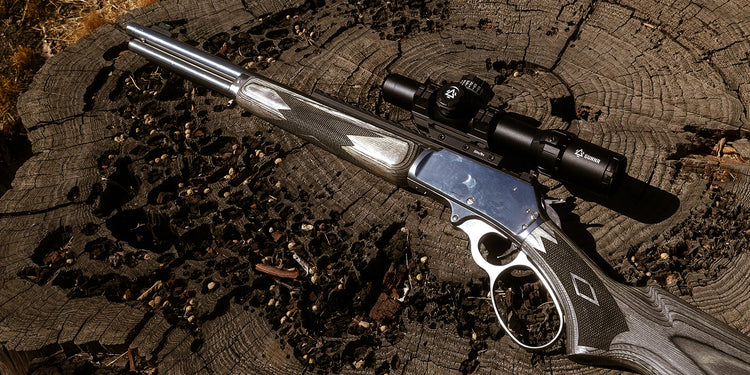The Evolution of Firearm Optics
The history of rifle scopes and optics is a journey of innovation, precision, and technology. From the simple iron sights used in early firearms to today's digitally enhanced smart optics, the evolution of sighting devices has revolutionized the accuracy, speed, and versatility of shooting. Whether used for hunting, competitive shooting, or military applications, advances in optical technology continue to push the limits of what shooters can achieve.
This article explores the transformation of rifle scopes—from early iron sights to cutting-edge thermal imaging and AI smart sights.
1. Early Firearms and Iron Sights (Pre-1800s - 1900s)
Before the advent of optics, firearms relied entirely on iron sights, which remain a basic aiming system to this day.
🔹What are Iron Sights?
Iron sights are physical sighting devices, typically made of metal, that help align a ranged weapon's barrel with a target. They are the simplest form of aiming device, relying on the shooter's eye and available light rather than magnification or illumination.
🔹 Key Developments:
- Mid-1500s: Early matchlock and flintlock rifles used crude iron sights, often just a simple notch and bead.
- 18th-19th centuries: Military muskets, such as the Brown Bess and Springfield Model 1861, adopted fixed or adjustable rear sights to improve accuracy.
- 1860s: Introduction of aperture sights (also called peep sights), which provide a more precise aiming picture by using a small hole to improve focus.
2. The Birth of Optical Sights (1800s - Early 1900s)
The first rifle scopes appeared in the 1800s as shooters sought greater accuracy at long range.
🔹 Early Optical Scope Innovations:
- 1835: Germán Schneider and later John Chapman experimented with basic telescopic scopes.
- 1855: Morgan James and William Malcolm introduced some of the first commercial rifle scopes, with adjustable magnification and built-in lenses.
- Civil War: Sharpshooters from both the Union and Confederate sides used early scopes to aim at targets at long distances.
🔹 Major Improvements in the Late 1800s-Early 1900s:
- Better lens coatings for improved clarity.
- Adjustable turrets for windage and elevation correction.
- Higher quality materials for increased durability and reliability.
By the early 20th century, scopes had become the standard for
precision shooting, especially in sniping and competitive shooting.
3. World War II and the Rise of Military Optics (1930s-1950s)
During World War II, rifle scopes made significant advances as countries prioritized accuracy in long-range combat.
🔹 Notable Military Scopes:
- Germany: Zeiss ZF39 mounted on the Kar98k sniper rifle.
- United States: M73 and M81/M82 scopes used on the Springfield M1903 and M1 Garand sniper rifles.
- Soviet Union: PU scopes used on Mosin-Nagant rifles by legendary snipers such as Vasily Zaitsev.
These scopes offered improved durability, magnification, and field of view, making snipers a vital battlefield asset.
🔹 Postwar Civilian Use:
After World War II, military scopes influenced civilian hunting and sport shooting, leading to the rise of companies that specialized in selling scopes.
4. Modern Tactical and Hunting Optics (1960s - 2000s)
Starting in the mid-20th century, rifle scopes became lighter, more accurate, and more adaptable to a variety of applications.
🔹 Key Developments:
✔ Variable Magnification Scopes: Scopes with adjustable zoom (e.g., 3–9x, 1–6x LPVO) became standard, supporting both close and long-range targeting.
✔ Mil-Dot Reticle: Initially developed and deployed in the 1920s–30s for broader military use, night vision technology was later integrated into rifle optics during the Vietnam War, enhancing the ability to engage targets at night.
✔ Expanded Use of Night Vision Optics: While night vision technology originated in the 1920s–30s, its integration into rifle optics and wide deployment occurred during conflicts like the Vietnam War.
✔ Red Dot & Holographic Sights: Became widely adopted for their speed and efficiency in close-quarters engagement, especially by tactical units and competitive shooters.
By the 2000s, shooters could choose from a variety of magnified scopes, reflex sights, and night vision optics to suit their needs.
5. The Future: Smart Optics and AI Integration (2010s-Present)
Today's rifle scopes are more advanced than ever, integrating electronics, sensors, and AI-based technologies.
🔹 Smart Scope Innovations:
💡 Digital scopes with built-in rangefinders – measure distance and automatically adjust aiming points.
💡 Thermal and infrared optics – detect heat signatures and can be used in military and hunting applications.
💡 Augmented Reality (AR) displays – provide heads-up target data.
💡 Ballistic calculators – automatically adjust to wireless
- Choosing a selection results in a full page refresh.


